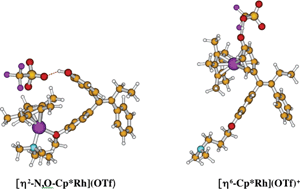The previously reported reactions of cis and trans-hydroxytamoxifen drug derivatives, 1 and 2, with [Cp*Rh(L)3]2+ complexes (L = H2O, CH3OH), initially provided the kinetically controled η1-N complexes, 4(OTf, CH3OH) and 5(OTf, CH3OH), which underwent a novel, intramolecular, regioselective N–π rearrangement to provide the η6 complexes, 6 and 7. A dramatic solvent effect was also observed on the rate of this N–π rearrangement in CH3OH or CH2Cl2. Therefore, a DFT study was conducted that provided further mechanistic and thermodynamic data on this N–π rearrangement. The preferred structures of both the η1-N and η6 complexes in the two solvents were determined, and a thorough analysis of their geometries and electronic structures has been provided. The influence of the solvent on the N–π rearrangement was studied by including the solvent both implicitly using a PCM model, and explicitly by introducing the counterion and/or the solvent molecules into the inner and outer coordination spheres of the complexes. It was shown that the triflate (OTf−) counterion was strongly bound in the inner coordination sphere of the η1-N complexes, 4(OTf) and 5(OTf), and in the outer sphere of the coordinatively saturated η6 complexes, 6 and 7, especially in non-polar media. The cleavage of the ionic Cp*Rh–OTf bond was found to be the rate-limiting step in the N–π rearrangement. The thermodynamic results suggested that the η6 complexes were more stable than the η1-N complexes in CH2Cl2 and in CH3OH at elevated temperatures. The opposite relationship for the stabilities of the η1-N complexes was found in CH3OH at room temperature, thus corroborating the experimental results that the N–π rearrangement did not occur, under these conditions. A plausible mechanistic pathway for the N–π rearrangement was proposed from our extensive DFT studies, that included several important intermediates and transition states, and provided a unique view of this novel transformation.


 Please wait while we load your content...
Please wait while we load your content...